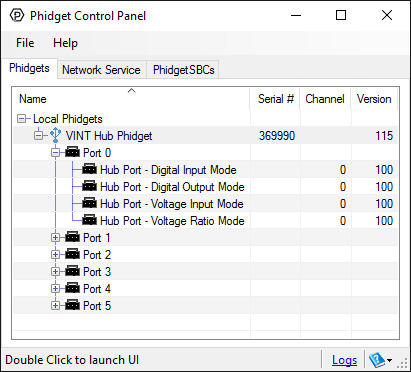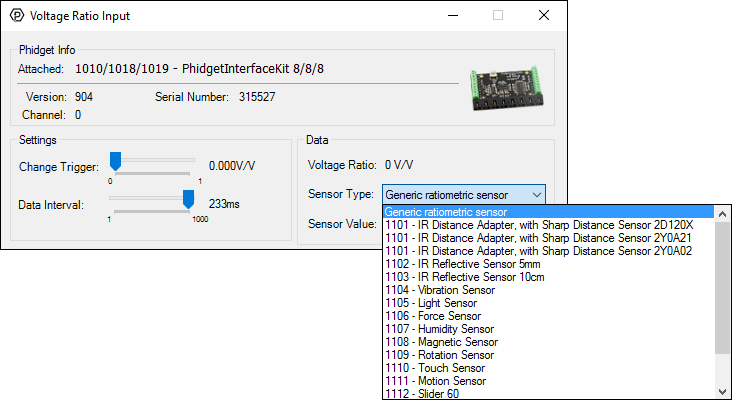1108 User Guide: Difference between revisions
No edit summary |
|||
| (17 intermediate revisions by 3 users not shown) | |||
| Line 1: | Line 1: | ||
__NOINDEX__ | |||
<metadesc>You can measure magnetic fields or sense a nearby magnet with the Phidgets Magnetic Sensor. Connects to an Analog Input or VINT Hub port.</metadesc> | |||
[[Category:UserGuide]] | [[Category:UserGuide]] | ||
==Getting Started== | ==Getting Started== | ||
{{UgSensorIntro|1108|IR Distance Adapter|Voltage Ratio Input port}} | |||
*Magnet to test the 1108 | |||
Next, you will need to connect the pieces: | |||
[[Image:1108_0_Connecting_The_Hardware.jpg|400px|right|link=]] | |||
# Connect the | # Connect the 1108 to the HUB0000 with the Phidget cable. | ||
# Connect the | # Connect the HUB0000 to your computer with the USB cable. | ||
= | <br clear="all"> | ||
{{UGIntroDone|1108}} | |||
{{ | ==Using the 1108== | ||
{{UGcontrolpanelSensor|1108|HUB0000}} | |||
{{UGSensorVoltageRatioInput|1108|Gauss}} | |||
{{ | |||
| | |||
==Technical Details== | ==Technical Details== | ||
===General=== | |||
The 1108 is optimized, sensitive, and temperature-stable. It is a ratiometric Hall effect sensor which provides a voltage output that is proportional to the applied magnetic field. Accuracy can be improved on a specific device with offset and/or gain calibration (using known flux). | |||
===Formulas=== | ===Formulas=== | ||
The Formula to translate | {{UGSensorFormula|Gauss}} The Formula to translate voltage ratio into Gauss is: | ||
{{ | :<math> | ||
\Phi \text{(G)}= (0.5 - \text{VoltageRatio}) \times 1000 | |||
</math> | |||
{{UGasens}} | {{UGasens}} | ||
{{UGnext|}} | |||
{{ | |||
Latest revision as of 22:02, 22 May 2018
Getting Started
Welcome to the 1108 user guide! In order to get started, make sure you have the following hardware on hand:
- 1108 - IR Distance Adapter
- Any Phidget with a Voltage Ratio Input port, here are some compatible products. We will be using the VINT Hub for this guide.
- USB cable and computer
- Phidget cable
- Magnet to test the 1108
Next, you will need to connect the pieces:

- Connect the 1108 to the HUB0000 with the Phidget cable.
- Connect the HUB0000 to your computer with the USB cable.
Now that you have everything together, let's start using the 1108!
Using the 1108
Phidget Control Panel
In order to demonstrate the functionality of the 1108, we will connect it to the HUB0000, and then run an example using the Phidget Control Panel on a Windows machine.
The Phidget Control Panel is available for use on both macOS and Windows machines. If you would like to follow along, first take a look at the getting started guide for your operating system:
Linux users can follow the getting started with Linux guide and continue reading here for more information about the 1108.
First Look
After plugging in the 1108 into the HUB0000, and the HUB0000 into your computer, open the Phidget Control Panel. You will see something like this:

The Phidget Control Panel will list all connected Phidgets and associated objects, as well as the following information:
- Serial number: allows you to differentiate between similar Phidgets.
- Channel: allows you to differentiate between similar objects on a Phidget.
- Version number: corresponds to the firmware version your Phidget is running. If your Phidget is listed in red, your firmware is out of date. Update the firmware by double-clicking the entry.
The Phidget Control Panel can also be used to test your device. Double-clicking on an object will open an example.
Voltage Ratio Input
Double-click on a Voltage Ratio Input object in order to run the example:

General information about the selected object will be displayed at the top of the window. You can also experiment with the following functionality:
- Modify the change trigger and/or data interval value by dragging the sliders. For more information on these settings, see the data interval/change trigger page.
- Select the 1108 from the Sensor Type drop-down menu. The example will now convert the voltage into Gauss automatically. Converting the voltage to Gauss is not specific to this example, it is handled by the Phidget libraries, with functions you have access to when you begin developing!
Technical Details
General
The 1108 is optimized, sensitive, and temperature-stable. It is a ratiometric Hall effect sensor which provides a voltage output that is proportional to the applied magnetic field. Accuracy can be improved on a specific device with offset and/or gain calibration (using known flux).
Formulas
The Phidget libraries can automatically convert sensor voltage into Gauss by selecting the appropriate SensorType. See the Phidget22 API for more details. The Formula to translate voltage ratio into Gauss is:
Phidget Cable

The Phidget Cable is a 3-pin, 0.100 inch pitch locking connector. Pictured here is a plug with the connections labelled. The connectors are commonly available - refer to the Analog Input Primer for manufacturer part numbers.
What to do Next
- Programming Languages - Find your preferred programming language here and learn how to write your own code with Phidgets!
- Phidget Programming Basics - Once you have set up Phidgets to work with your programming environment, we recommend you read our page on to learn the fundamentals of programming with Phidgets.

